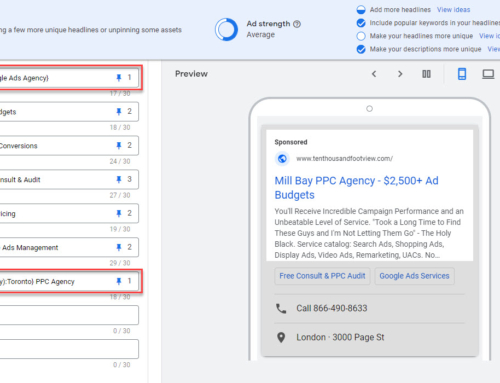Here at Ten Thousand Foot View, we are constantly auditing Google Ads accounts. Time and time again we see these 5 common Google Ads mistakes made by DIYs. If you manage your own Google Ads campaign and aren’t seeing the results you desire then this may help – fix any or all of these common Google Ads issues and you’re bound to see a huge boost in performance.
Note: This article was updated on September 7th, 2021.
#1 – Improperly Installed or No Conversion Tracking
Conversion tracking is the cornerstone of campaign performance management. With conversion tracking properly installed you’ll not only be able to manually optimize your campaigns but will also be able to turn on automated optimization features for both bidding and creatives. Without it, you’ll have absolutely no idea what keywords, ads, ad groups and campaigns are driving leads or sales for your business. There are a few different ways to set up conversion tracking depending upon your skill level and type of business. If you’re not sure what to do you should hire an expert. In the example below, it appears that conversion tracking is set up but zero conversions in 30 days probably indicates an incorrect installation.

Besides simply not having conversion tracking installed we often see the conversion action set to the landing page rather than the “thank-you” confirmation page. If the number of conversions in your campaign are almost equal to the number of clicks you’ve sent to your landing page then you’ve done this wrong. A Google Ads conversion tracking script or Google Analytics Goal should be placed on or set to the thank-you page respectively. If you don’t load a “thank-you” page on form submission you can also create a custom form submission event and link it to a Goal – see your web developer to set this up.
Lastly, it’s important these days to choose the right attribution length and model based on your campaign goals. Leaving these set to 30-days and last-click attribution are almost never the right choice.
#2 – Failure to Set Proper Bid Adjustments When Using Manual Bidding
If you’re using manual bidding you need to stay on top of a plethora of potential bid adjustments in order to properly optimize your campaign.
When was the last time you checked to see what devices are converting best or what time of day or what days are generating the highest conversion rate? Are most of your leads coming from one geographical location in your target area? How about adjusting demographics and audience bids?
With additional tweaks to targeting with this in mind, we’ve seen an increase in conversions rates up to 50%. Importantly, bid adjustments should always be set based on the campaign goal, which is typically the CPA for lead generation or ROAS for sales.
Check out the day of week dimension report below – look at how much better Sunday converts vs. Wednesday; why not set up a bid schedule by day to optimize your daily ad spend?

Of course, if you’re using Smart Bidding, many of these bid adjustments won’t be necessary. It’s a good idea to familiarize yourself with what bid adjustments work with what bidding strategies from these tables provided by Google.
#3 – Choosing the Wrong Bidding Strategy
There is a lot of confusion about when you should be using different bidding strategies. Most of this confusion can be avoided if you start by identifying what opinions align with your campaign goals. For example, if you are interested in conversion volume, that leaves just the following options for you:
- Maximize conversions
- tCPA (target cost per action)
- manual bidding
- ECPC bidding (enhanced cost per click manual)
Next, choosing manual, ECPC, or one of the remaining automated bidding options will depend on conversion volume. These days, if you’re getting at least 15 conversions per month in your campaign it’s likely that fully automated bidding will work best for you.
Let’s say you’re currently running ECPC and considering moving to fully automated because you have 50 conversions per month on average. You could just make a switch, or you might consider running an experiment to see how automated bidding runs against your current strategy.
Either way, you need to choose between Max Conversions and tCPA. This choice is pretty easy really. Do you want to run a fixed budget each month and get as many conversions as possible? Or, is it more important to stick to a consistent cost per action while having variable spending? If your answer is the former you should choose Max Conversions, and the latter, tCPA.
There are also some gotchas with bidding strategies that you need to be aware of.
For example, if you have a budget that’s much higher than what you typically spend and you switch to Max Conversions, you might see your CPA and spending go through the roof. Always cap your budget at around your typically daily spend before making this switch, or its counterpart Max Conversion Value.
For a full guide on bidding strategies, check out our The Right Google Bidding Strategy For You article.
#4 – Incorrect Application of Ad Extensions
Ad Extensions are amazing and can make a huge difference in the bottom line when used properly. Unfortunately, we often see people either using none of the extensions or using all of them when it simply doesn’t make sense. Here’s a rundown on some solid use cases for each ad extension type:
Location Extension – Use it when being local matters, otherwise skip it
Call Extension – Use it when you want people to call you; if you prefer people don’t call you then don’t include it. Also keep in mind that if your campaign runs 24/7, people may call your number 24/7… are they going to reach somebody at 2 AM on Sunday morning? Fortunately, you can schedule call extensions only to show when you’re typically able to answer their call.
Sitelinks – Use these only when links to other pages of your website add significant value to your offer. Remember that you have invested (hopefully) lots of thought, time and perhaps money into your landing page. A click on any of your Sitelinks will divert traffic away from that landing page. Also note that with Sitelinks enabled Google may not be displaying other more valuable Ad Extensions such as your address, phone number or Callouts.
Callouts – I can’t think of too many times you wouldn’t want to use Callouts. These are perfect for adding additional benefits and features for your products or business that you can’t fit directly in your ads.
Image – These are fairly new and generally run only on mobile devices so far. We’ve seen an increase in CTR when using them so I generally recommend adding them for almost every campaign.
Promo – Promo extensions are absolutely amazing and perfect for any business that routinely runs different sales. You can set these to run on certain dates and offer monetary or percentage base discounts with or without a coupon code. Furthermore, you can link to the exact promotion. You should run these for any promo you have.
Others – Each extension has an appropriate use case. Think carefully about whether or not this enhances your offer to guide you on whether or not to include it.
Also, keep in mind that many extensions such as Sitelinks and Callouts offer you the ability to split test. Ensure you monitor performance on a regular basis and swap out low performing variations for new ones.
#5 – Campaign Bloat
This is an issue we see particularly often in older accounts though we do see it from time to time in newly launched accounts as well. The problem is pretty simple… a small budget campaign with way too many keywords, ads and ad groups. When you build your campaign like this it will take months and months to get any meaningful/actionable data to optimize for. Think about it…. you start a campaign with a plan to get 10 clicks per day and then introduce 10 ad groups with 4 ads and 20 keywords in each group.
Assuming you have chosen keywords that have a reasonable amount of search volume and all things being equal after 3 months you have 90 clicks per ad group, 23 clicks per ad and 5 clicks per keyword. Unless you have an extremely high conversion rate it is very unlikely you will be able to detect any trends in performance. Now, it is fair to say that ad and keyword clicks are never distributed evenly like this but still… there is no way to find those golden keywords when you’re spreading your ad spend too thin.
There are only 2 cures for campaign bloat…. either tighten things up significantly (fewer ad groups, ads and keywords) or dramatically increase your ad spend.
Summary
Besides these problems, we come across frequently in DIY Google Ads accounts we see many other issues that negatively affect performance. If you believe you’ve implemented everything correctly in Google Ads and still aren’t seeing great results feel free to get in touch with us. We’d be happy to take a high-level look at your account and let you know if we can help – no charge!





